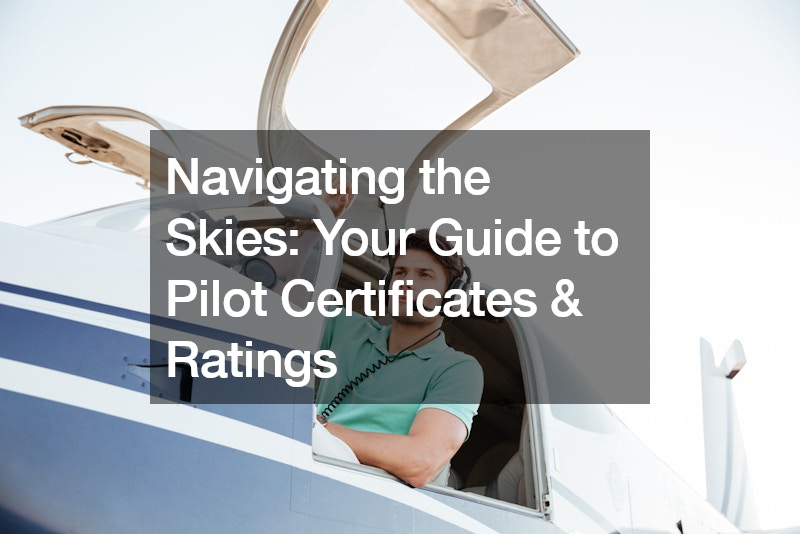
Many share the dream of taking flight, of soaring through the clouds with the wind as their guide. For those who aspire to become pilots, the journey is marked by milestones, each represented by different certificates and ratings. These credentials not only signify achievement but also open doors to new opportunities and responsibilities within the realm of aviation.
1. Student Pilot Certificate
This initial step is akin to dipping one’s toes into the vast ocean of aviation. Aspiring pilots, typically aged 16 or older, embark on their journey by obtaining a Student Pilot Certificate.
This credential is accompanied by the exhilarating experience of solo flight under the watchful eye of a certified flight instructor. It marks the beginning of a lifelong love affair with the skies.
2. Private Pilot Certificate
With wings spread wider, pilots progress to the Private Pilot Certificate, a pivotal moment in their aviation journey. Now, they have the privilege of taking friends and family up into the blue yonder. The requirements for this certificate include being at least 17 years old, demonstrating proficiency in English, and accumulating a certain number of flight hours, including cross-country and night flying. This milestone empowers pilots with the freedom to explore the skies on their own terms.
3. Instrument Rating
As pilots advance in their skills and ambitions, they often seek to enhance their capabilities by obtaining an Instrument Rating. This qualification enables them to navigate through challenging weather conditions, relying solely on instruments. It’s a testament to their mastery of the craft, allowing them to soar above the clouds even when visibility is limited.
4. Commercial Pilot Certificate
For those who dream of turning their passion for flying into a career, the Commercial Pilot Certificate is a crucial step forward. This credential, earned through commercial pilot training, grants pilots the ability to get paid for their time in the cockpit. With heightened responsibilities come increased requirements, including a significant number of flight hours and, in some cases, an instrument rating. It’s a milestone that opens doors to a variety of opportunities, from flying cargo to conducting aerial tours.
5. Airline Transport Pilot (ATP) Certificate
The pinnacle of achievement in the world of aviation, the ATP Certificate is the key to the kingdom of commercial airline flying. Pilots who attain this credential have demonstrated the highest levels of skill, experience, and professionalism. With a minimum of 1,500 flight hours under their belt, along with comprehensive testing and a first-class medical certificate, they are entrusted with the safety and well-being of countless passengers as they navigate the skies as commercial airline pilots.
The Journey Ahead: Challenges and Rewards of Becoming a Pilot
For aspiring pilots, the journey towards earning their certificates and ratings is not just a series of checkboxes to tick off–it’s a transformative experience that comes with its own set of challenges and rewards. As they set their sights on the skies, they must prepare themselves for the road ahead, filled with both triumphs and tribulations.
Challenges
- Financial Investment: Aviation is not a pursuit for the faint of heart–or wallet. The cost of flight training, aircraft rental, exams, and certifications can add up quickly, presenting a significant financial barrier for many aspiring pilots.
- Technical Complexity: Mastering the art of flying is no small feat. From understanding aerodynamics to navigating complex airspace, aspiring pilots must grapple with a myriad of technical concepts and procedures. Learning to operate and maintain aircraft safely and efficiently requires a keen intellect, attention to detail, and a willingness to continually learn and adapt.
Rewards
- Freedom and Adventure: The ability to chart one’s own course, explore new horizons, and experience the world from a unique perspective is an exhilarating prospect. Whether soaring over majestic landscapes or touching down in far-flung destinations, aviation opens up a world of possibilities and adventures waiting to be discovered.
- Career Opportunities: Aviation offers a diverse range of career opportunities besides the thrill of flying. From commercial airline piloting to aerial firefighting, aerial photography, and beyond, the sky’s the limit when it comes to potential career paths.
Personal Growth and Fulfillment: Aspiring pilots are challenged to push past their comfort zones, overcome obstacles, and explore new skills and perspectives.
Closing Thoughts
Aspiring pilots embark on this journey with a sense of awe and excitement, knowing that each certificate and rating brings them one step closer to their ultimate goal. Along the way, they face challenges, setbacks, and moments of triumph, all of which contribute to their growth and development as aviators.
However, aviation is not just about flying planes. It’s about pushing boundaries, conquering fears, and experiencing the sheer joy of flight. It’s about connecting with the world from a perspective few will ever know and pursuing a passion that transcends mere occupation. So, whether you’re just starting out as a student pilot or aiming for the lofty heights of an ATP Certificate, remember this: the sky is not the limit–it’s just the beginning of an incredible journey.
.

